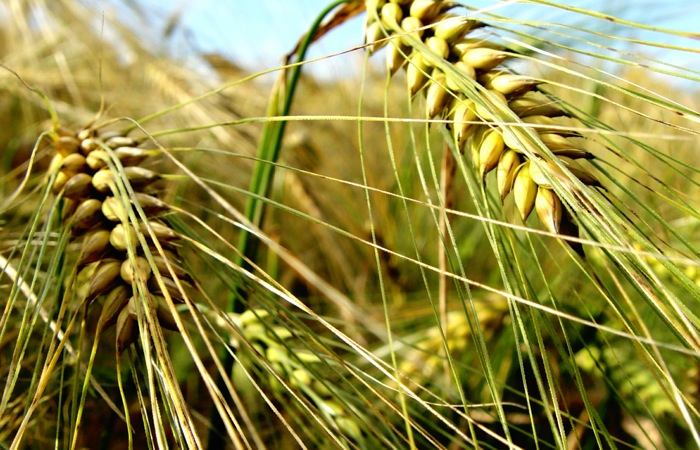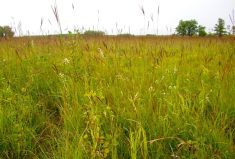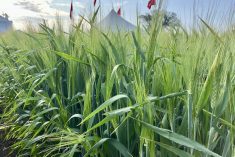Improving the quality and efficiency of feed was the topic of the day at the Alberta Beef Industry Conference workshop put on by the Feed Coalition, an alliance of Alberta producer associations and research organizations.
Alberta alone grows more barley than all of the U.S. and not many know barley quality better than researchers with Alberta Agriculture’s Field Crop Development Centre (FCDC) at Lacombe, Alta.
Over the last 41 years, the centre has released 32 barley varieties, 23 of which are feed varieties, and since 1993 has developed 30 near-infrared reflectance spectroscopy (NIRS) quality characteristic calibrations for barley.
Read Also

Body condition, nutrition and vaccination for brood cows
One of the remarkable events of the past century related to ranching has been the genetic evolution of brood cows….
An NIRS scan is like a sample’s fingerprint because each component in a sample absorbs differing amounts of light energy from the spectrum, explains Lori Oatway, cereal quality research scientist with Alberta Agriculture’s feed crops branch. The NIRS fingerprints are compared to chemical analysis results to develop unique mathematical equations for each characteristic for each grain type. The equations are then used to calibrate the NIRS instruments to predict each characteristic.
Developing NIRS technology for quick, accurate sample analysis has been an FCDC priority because there are at least 20,000 and upwards of 40,000 samples from the breeding program to scan between harvesting the plots and March when breeders need to make their selections for planting in spring.
The more data collected from the FCDC’s and collaborators’ research projects and feeding trials, the stronger the calibrations become over time. From equations for protein, starch, lysine and moisture calibrations 22 years ago, researchers are now working on calibrations for complex traits such as digestible energy content, protein digestibility and fibre digestibility.
“Feed quality is one of our highest priorities and all of our varieties (feed, hulless and malt barley classes, triticale and winter wheat), are screened for feed quality traits both as grain and forage in all trials,” Oatway says. “When we develop a variety, the lines are assessed for yield because we want you to have a high return on your investment, so we want varieties that yield the most on the least amount of land with the least amount of inputs. We look at agronomic traits, with lodging resistance and earliness being very important, and we look at the enhanced quality traits. For disease resistance, we have collaborators around the world testing resistance to stripe rust, smut, fusarium head blight, root rot, scald and blotch.
“Choose your variety carefully because quality can’t go beyond the genetic potential of the variety. Varieties are unique, that is we can’t just say it’s a two row or a six row and know its quality. Different varieties are developed for different reasons so not all varieties within the classes have equal quality traits.”
To illustrate her point, Oatway highlights some of the quality characteristics of a few FCDC varieties.
Amisk, a six-row feed barley, is unique because of its improved plumpness (five per cent better than the two-row malt leader, AC Metcalfe), so it processes quite evenly and is useful for forage as well.
Bentley was bred as a two-row malt variety, but its high yield (13 per cent higher than AC Metcalfe) is comparable to feed barley yields. It’s marketed as a triple-purpose variety, so if you are planting barley in hopes of getting a malt premium, but that doesn’t work out, you won’t lose anything on yield potential or biomass production.
Sundre is a smooth-awned six-row feed with a very good disease and yield package.
Another smooth-awned variety, Gadsby, is a two-row feed barley with a nice plump kernel along with strong grain and forage yield. It has performed well in feeding trials because of its unique quality traits being higher in starch and digestible energy content and lower in fibre than Xena.
For detailed information on FCDC varieties, go to Alberta Agriculture’s website.
Choosing barley varieties for forage
Looking at plots, seed guides and advertisements will tell you something about the varieties for forage but each has its limitations. For instance, leaf content will be important because it is a very nutritious component of the plant, but it may only represent 10 per cent of the crop dry weight. There are characteristics you can’t see, such as stem cell walls and other undigestible material, but that could be offset by starch in the grain. At the silage stage, grain may represent 35 to 45 per cent of the weight, and stems, which are the least digestible, may represent another 35 to 45 per cent with awns and chaff making up the rest. So looking at plots likely won’t tell the whole yield and quality story. There are also a lot of varieties with very good forage potential that aren’t marketed as forage types.
Baron recommends studying results from replicated standard agronomic variety trials, such as the western co-operative barley forage trials used for variety registration and provincial trials. They provide the best yield and quality data because of the controlled production schedule with harvest at the proper stage. Choose varieties with the best performance in the trial location closest to your farm to reduce agronomic risk associated with soil type, environment and disease pressure. Finally, yield and quality for the same variety differs from year to year and location to location, so look at yield and quality stability across locations and years to narrow your choices to varieties with the least variation in performance.
High quality results in higher rates of gain for backgrounding feedlot animals and, while feed quality is important for swath grazing beef cows, high yield always dominates in the economic analysis for swath grazing, he says. High yields translate into lower cost per unit of production and higher carrying capacity to decrease acres used for swath grazing or graze more animals on the same amount of land.
In swath-grazing trials at Lacombe, triticale planted in the first part of June yielded 50 per cent more tonnage than late-seeded barley. The corn cost more to seed, therefore, would have to yield more and have higher quality, which it did, Baron says, but the high-yielding triticale saved the most money compared to the barley silage-barley straw control.
“We like to see low variation for quality with high yield. We see a lot of material in the system with relatively low quality variation but not high yielding, probably typical of barley-breeding programs for grain,” Baron says. “We also see varieties with the best carrying capacity (yield) but the fact is they’re just not that high for forage quality (high digestibility and low fibre resulting in good rates of gain); other varieties that provide better rates of gain tend to be lower yielding, so we have some work to do to bring information together so we can do a better job selecting material for new lines.”
New rate-of-gain index in development
Quality and yield information for each variety is entered into the spreadsheet to project rate of gain and cost per pound of gain for each variety.
The rate-of-gain component factors in all of the feed-quality parameters. In Baron’s barley example, this information was obtained by NIRS predictions for varieties that have been released by the FCDC, new lines in development and other varieties grown for years at FCDC sites (Lacombe, Olds, Trochu, Calmar).
The cost-of-gain equation factors in the value of each kilogram of feed produced (cost of growing the crop divided by yield), the amount fed and the estimated rate of gain. Therefore, the ranked results are specific to a growing region and to the class of animals being fed.
“The sole purpose is to compare varieties grown within the trial and the comparison is best for those managed the same way,” Baron says, stressing that the new tool isn’t a ration-formulating program to balance all ingredients in a ration or figure out a least-cost ration. “It could be used along with existing data from the trials or a producer could use it to compare varieties where the basic yield and quality data is supplied. One way or the other, you will be able to use the information to help choose the variety that would be the least risky to grow and feed in a backgrounding program on your farm.”
His example compares barley cultivars grown in the Olds-Edmonton area and fed to 550-pound steers on a full silage diet. Surprisingly, a food-type two-row barley ranked the highest with a rate-of-gain projection of 1.94 pounds per day at a cost of 32 cents per pound of gain. Another food type ranked second in the two-row class with the same rate-of-gain (1.61 pounds) and cost-per-pound-of-gain (38 cents) projections as the third-ranked six-row feed barley.
In the six-row category, a semi-dwarf variety came out on top with potential to produce 1.87 pounds of gain per day at a cost of 34 cents per pound of gain. A variety specifically bred as a feed-forage type ranked lowest among both the two-row and six-row varieties with a projected rate of gain of 0.93 pound per day at a cost of 66 cents per pound of gain.
“The reason these costs of gain may seem low to the cattle feeder is that they are determined using plot yields, which are usually greater than one might get from farm fields. The average of the varieties’ estimated rates of gain were about 1.2 pounds per day. So we can see that there is some exceptional genetic material that hasn’t necessarily been identified for the feeding industry,” says Baron.
“I knew there would be differences, but was surprised to see the amount of difference,” Baron says. “The quality traits that appear to be the most important for rate of gain are acid detergent fibre for digestibility and neutral detergent fibre for intake, but we would also like to have high starch content because that’s rapidly digestible and we would like to have high fibre digestibility.”
Taking it a step further, Baron wanted to see how variety choice would affect risk on the farm. Quality data from the spreadsheet for varieties in the Lacombe trial and five years of cost-price data for 550-pound steers fed for 150 days was used to create a distribution of gross margin for each variety. The cost-price data included purchase prices in November, trucking, induction costs, feed costs, yardage and April sale prices with a slide for 700-weight cattle. At the end, they looked at rates of gain and break-evens for each of the five years to come up with the probability of loss depending on the variety chosen.
“The two-row and six-row varieties that ranked near the top would have at least been better than breaking even four out of five years and most of the six-row varieties would have made money four out of five years,” Baron says, adding that the distribution may have been different for varieties grown in another area where two-row types may have had an advantage. Keep in mind factors such as resistance to leaf diseases and lodging.
Lower varieties on the index would have been successful in only one or two years.
One year the market was so good money was made regardless of the variety fed. In another year all trials lost money, although choosing a variety with a higher rate of gain and higher yield would have helped limit the loss. The hitch is that when you buy your seed for spring you don’t know what will happen six months to a year down the road.
“So we see that it differs from year to year how important it is for you to choose the best variety. So it would make some sense economically for you to choose the better types. It would provide the best chance of success,” he says.



















